Bee Informed: Warming and Swarming
Arizona Community Integrated Pest Management
Only experienced and licensed staff, contracted pest management serviceproviders, or beekeepers should tackle honey bees.
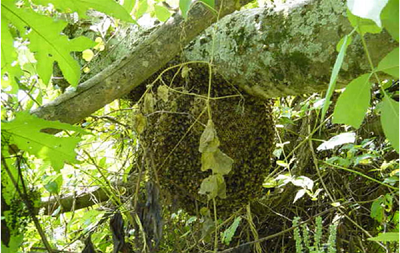
You may be noticing that wild honey bees are more noticeable foraging in your landscapes, but that doesn’t mean there hasn’t been busy bee activity all winter long.
If you are located in the colder regions of the U.S., wild honey bee colonies just hunker down and cuddle. They do not hibernate, and mortality can be high with older bees dying off over time. But if a wild colony has set up home in a sunny spot, protected from wind and flooding (Fig. 1), activity never stops inside the comb. Assuming the queen is healthy, and the colony has plenty of stored honey and pollen accessible to them, they will shiver their way through the winter months. Quite literally, the worker bees cluster around the queen and shiver to maintain an internal colony temperature significantly higher than the outside ambient temperature.
Under subtropical, tropical, and mild winter conditions, egg laying and brood rearing slows down, but doesn’t stop. As the spring days lengthen, and temperatures increase, plants generating new sources of pollen and nectar stimulate the rearing of brood (baby bees). Bees forage for food and water to regulate temperature and liquefy crystalized honey to feed the brood. With the successful rearing of young and emergence of worker bees, the colony will eventually become overcrowded. This necessitates swarming.
What is honey bee swarming?
When it comes to colonies and queens, there can be only one. The queen bee in an active hive is rarely seen outside and hardly ever needs to fly. She stays deep inside the comb, is cared for by the worker bees, and continually lays eggs. Honey bee queens produce a pheromone that inhibits the production of new queen bees.
But as colonies become increasingly crowded the message fails to make it to all the bees, or older queens begin to produce lower levels of the pheromone. Uninhibited worker bees create larger elongated rearing cells called queen cups. Once eggs in the queen cups hatch the larvae are given special care and are fed with a food called royal jelly. Worker bees tending the existing queen give her less food, and egg production slows as the queen loses body weight, which will ultimately help her to fly. When new queens are almost ready to emerge from the queen cups, the old queen takes most of the workers and departs. The traveling mass of bees is called a “swarm”.
Before leaving, the workers fill their stomachs with honey, and this is the only food the swarm has to sustain activity until they find a new home site in which to establish their new colony. The old queen, being a weak flyer will often land suddenly, and often not far from the original hive. Resting swarms can be found clustered on the ground, on a fence post, a tree limb, or the side of a building (Fig. 2), and workers will quickly surround the queen to regulate her temperature. Since swarming bees are focused on finding a new home, they are not generally defensive and rarely pose any danger to humans or other animals. Swarming is common during spring and continues throughout the year while pollen and nectar sources support growing colonies. This is greatly influenced by environmental conditions. In the low desert southwest, plants are already blooming, and bee experts report that wild honey bee swarming began weeks earlier than usual.
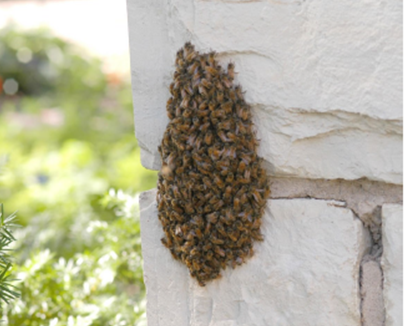
While the old queen takes a mini break several hundred scout bees will leave the swarm and explore the surroundings in search of a new home site. When a scout discovers an appealing location, the scout will perform recruitment dances to persuade the other bees to investigate the site. What follows is a literal debate over several days, all communicated in dance. After multiple site visits and a veritable dance-off between scout bees they reach a consensus regarding the new location. The scouts then guide the swarm to the chosen site, which can be several miles from the original colony. A swarm needs to build a new hive before the honey reserves in the workers’ stomachs is depleted. If the weather is not favorable and/or food sources are unavailable, the swarm can starve and suffer significant mortality.
Once settled, workers will start building a new comb. The queen will start laying eggs, and workers will carry out all other duties for the colony including foraging, cleaning, hive building, guard duty, comb ventilator, and nanny for the brood.
Back in the original hive, the first queen to emerge will sting and kill other emerging queens. The old hive usually has enough food reserved to last the colony for a while, but it is important to start building up the number of worker bees once more. The new virgin queen will mature after several days and fly out to seek drones in areas called “drone aggregations”. She will mate multiple times with several drones and will store sperm for the remainder of her lifetime. After mating, she will return to the hive and start laying eggs, slowly building up the colony.
Sometimes newly emerged virgin queens will leave the hive with a group of workers in another swarm, called an
“after swarm”, and this can occur repeatedly until the old hive is depleted and dies off.
How to identify a swarm?
If a cluster of bees suddenly appears on a wall, on a branch of a tree or on the ground and remains exposed, this is most likely a resting swarm. Swarming bees will not have yellow or orange pollen evident in pollen baskets on their hind legs, and swarms will not be seen moving in and out of cavities. Swarms will often move on in a few days without intervention and although not defensive, they can sting if disturbed. It is best to observe the swarm from a distance and hope they do not find suitable nesting sites close to or in your home or building.
What to do when you see a swarm?
It is best to leave swarms alone if they are in a spot that does not have much human traffic passing close by, e.g., a swarm on a wall that can be cordoned off using caution tape. But if a swarm is in the way of people in a location that cannot be avoided, seek the help of an experienced professional to remove swarms. If swarms are disturbed, they will disperse within a local area and this can cause people to panic.
Have staff or contacted pest management professionals who can respond rapidly to wild honey bee swarms when necessary. Local beekeepers or beekeeping associations often help. Most states have their own beekeeper’s association, and many are active on social media. Some beekeepers will collect swarms and use them to start new hives. Information for the Arizona Beekeepers Association can be found at https://www.azbeekeepers.org/. The website provides a list of beekeepers that might be able to assist with bee removal.
Wild honey bee colonies
Compared to swarms, established colonies in and around homes, schools, and other buildings pose greater risks to people (Fig. 3 and 4).
Wild honey bees can become pests because of sting incidents, defensive bee attacks, and the structural damage and annoyance that their foraging and nest-building activities can cause. The chances of people getting stung in such situations are much higher once brood are being reared.
Bees and combs should be removed by professionals who have appropriate personal protective equipment.
Most honey bees observed in the landscape are foraging bees from established colonies looking for water, nectar or other sugary, sweet-smelling substances. If you observe bees passing in and out of a cavity, this indicates the presence of a colony within.
Honey bees and other pollinators are important and desirable elements in our natural environment. But wild honey bees can sometimes interfere with our activities or interests. When this happens the best course of action is to take an integrated pest management (IPM) approach.
Five proactive honey bee management points
1. Always identify the insect before deciding if it is a real problem
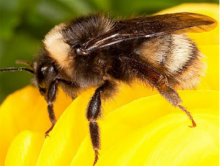
There are many kinds of bees and bee-look-alikes, some of which belong to other insect orders, such as the hover flies. Most bees and bee-look-alikes are beneficial or benign and do not necessitate action, e.g. bumble bees and leaf-cutter bees; while some close relatives can pose risks, e.g., yellowjackets and paper wasps. If you are unsure about an insect and would like to have it identified, contact the University of Arizona Insect Diagnostics service. Contact details and instructions for sample submission can be found at https://cals.arizona.edu/ENTO/content/insect-id. You are welcome to submit insect specimens, if you can safely collect them. You can also send in insect pictures for identification.
2. Inspect and monitor your home and surroundings regularly for signs of honey bee activity.
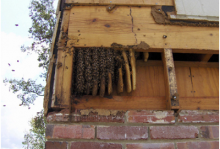
Encourage community members to report swarm sightings, and actively look for newly arrived colonies during warm months of the year.
3. Be aware of potential health and injury risks.
It is important to be aware of stinging insect activity in an area before engaging in outdoor activities, particularly if individuals sensitive to stings are involved. Avoid contact with these insects as much as possible and teach children to do the same. Tragic loss of life has occurred when people intentionally irritated honey bees. Teach children to respect bees and never to throw things at colonies or disturb them in any way. Swarming or foraging wild honey bees are usually focused on their respective jobs, but can sting if they feel threatened or are accidentally crushed against the skin. Established colonies may be highly defensive and may respond in large numbers if provoked. Beeware landscapers and groundskeepers, loud noises, vibrations, blowing dust, and physical disturbance of hives is threatening to bees protective of their brood.
4. Respond appropriately to honey bees around you.

- If you encounter bees buzzing around your head, place your hands over your face and look through gaps between your fingers. Look around for signs a colony is close by and walk briskly away from the area. Do not flap or swat at the bees, this is the worst thing to do!
- If bees bump or sting you, cover your head and face with clothing or your hands and run to the nearest building, car or any kind of shelter. Go inside and close the doors. If you are not close to a shelter, run or walk briskly for at least 240 yards (the length of two football fields) or as long as you can go until the bees have abandoned you.
- Do not dive into a swimming pool or river; the bees will wait for you for far longer than you can hold your breath, and they can see you below the surface of the water.
- If stung, and once you are in a safe place promptly remove stings from your skin using any available means (e.g., tweezers, your fingernail, a pocketknife, or credit card). Scraping them off quickly will greatly reduce the severity of the sting reaction.
Most healthy adults can withstand several hundred bee stings, so fatalities due to toxic levels of venom are extremely rare. Bee stings are painful, and the discomfort and swelling can last 2-3 days. Prolonged or severe reactions may occur in sensitive people, and this is the most significant problem. Communicate with those you work with if you have severe sensitivities and carry an EpiPen.
5. Prevent bees from nesting in and around your buildings
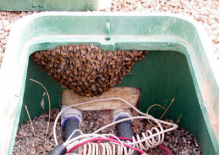
Honey bees need food, water and shelter to survive. Restricting access to suitable nesting sites will encourage them to go elsewhere to live. Filling gaps and entry points into wall voids is an excellent and cost-effective preventative action. Understand and select landscape plants appropriately, avoiding those most attractive to honey bees if you manage landscapes occupied by sensitive or vulnerable populations. Manage trash and food waste in outdoor areas keeping bees and wasps in mind. Pop cans, sugary drinks, and food waste attract foraging bees and wasps. Placing open topped trash receptacles next to doorways may be practical from one perspective, but encourages honey bees and wasps to forage near to doorways, and some will gain access to building interiors as a result.
The Sonoran desert region is home so more than 1000 bee species, and areas around Tucson are assumed to host a greater diversity of species than anywhere else in the world. We have the world’s smallest bee Perdita minima, which is a diminutive 2 mm in size, and gentle giant Xylocopa carpenter bee, that can be up to 40 mm in length, and weigh over a gram! Prepare to “bee” amazed.

